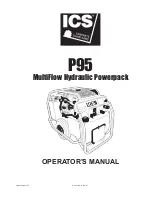
5
English
•
Use the tool only for its intended use. Do not
discharge fasteners into open air, concrete, stone,
extremely hard woods, knots or any material
too hard for the fastener to penetrate. Do not
use the body of the tool or top cap as a hammer.
Discharged fastener may follow unexpected path and
cause injury.
•
Always keep fingers clear of contact trip to prevent
injury from inadvertent release of the pusher
.
•
Refer to the
Maintenance
and
Repairs
sections for
detailed information on the proper maintenance of
the tool.
•
Always operate the tool in a clean, lighted area.
Be
sure the work surface is clear of any debris and be careful
not to lose footing when working in elevated environments
such as rooftops.
•
Do not drive fastener near edge of material.
The
workpiece may split causing the nail to ricochet, injuring
you or a co‑worker. Be aware that the fastener may follow
the grain of the wood (shiner), causing it to protrude
unexpectedly from the side of the work material. Drive the
chisel point of the fastener perpendicular to the grain to
reduce risk of injury.
•
Do not drive fasteners onto the heads of other
fasteners or with the tool at too steep an angle.
Personal injury from strong recoil jammed fasteners, or
ricocheted fasteners may result.
•
Keep hands and body parts clear of immediate work
area.
Hold workpiece with clamps when necessary to
keep hands and body out of potential harm. Be sure the
workpiece is properly secured before pressing the stapler
against the material. The contact trip may cause the work
material to shift unexpectedly.
•
Do not use tool in the presence of flammable dust,
gases or fumes.
The tool may produce a spark that could
ignite gases causing a fire. Driving a fasteners into another
fasteners may also cause a spark.
•
Keep face and body parts away from back of the tool
cap when working in restricted areas.
Sudden recoil
can result in impact to the body, especially when stapling
into hard or dense material.
•
Grip tool firmly to maintain control while allowing
tool to recoil away from work surface as fastener
is driven.
•
Choice of triggering method is important.
Check the
manual for triggering options.
•
Always select an actuation system that is appropriate
to the fastener application and the training of
the operator.
•
Use caution when handling, loading or unloading
fasteners.
Fasteners have sharp points which could
cause injury.
•
Only wear gloves that provide adequate feel and safe
control of the trigger and any adjusting devices.
•
Be aware of material thickness when using stapler.
A
protruding fasteners may cause injury.
in the mode selection section of the manual. If it doesn’t
perform according to the manual, stop using the tool
and have it serviced at an authorized service center.
•
Keep hands and body parts away from the discharge
area of the tool.
While in use NEVER grasp the tool by the
magazine or canister, a mis‑driven fasteners can exit the
nose causing injury.
•
Hold tool by insulated gripping surfaces when
performing an operation where the fastener may
contact hidden wiring.
Contact with a “live” wire will
make exposed metal parts of the tool “live” and shock
the operator.
•
Actuating tool may result in flying debris, collation
material, or dust which could harm operator’s eyes.
Operator and others in work area MUST wear safety glasses
with side shields. These safety glasses must conform to ANSI
Z87.1 requirements (approved glasses have “Z87” printed
or stamped on them. It is the employer’s responsibility to
enforce the use of eye protection equipment by the tool
operator and other people in the work area.
•
Always wear appropriate personal hearing and other
protection during use.
Under some conditions and
duration of use, noise from this product may contribute to
hearing loss.
•
Disconnect battery pack from the tool when not in
use.
Always remove battery pack and remove fasteners
from magazine before leaving the area or passing the tool
to another operator. Do not carry tool to another work area
in which changing location involves the use of scaffoldings,
stairs, ladders, and the like, with battery pack connected.
Do not make adjustments, perform maintenance or clear
jammed fasteners while battery is in place.
•
Do not remove, tamper with, or otherwise cause the
tool, trigger or trigger lock‑off,
to become inoperable.
Do not tape or tie trigger in the on position. Do not remove
spring from contact trip. Make daily inspections for free
movement of trigger. Uncontrolled discharge could result.
•
Inspect tool before use. Do not operate a tool if any
portion of the tool, trigger, or trigger lock‑off is
inoperable, disconnected, altered, or not working
properly.
Damaged parts or missing parts should be
repaired or replaced before use. Refer to
Repairs
.
•
Do not alter or modify the tool in any way.
•
Always assume that the tool contains fasteners.
•
Do not point the tool at co‑workers or yourself at
any time.
No horseplay! Work safe! Respect the tool as a
working implement.
•
Keep bystanders, children, and visitors away while
operating a power tool.
Distractions can cause you to
lose control. When tool is not in use, it should be locked in a
safe place, out of the reach of children.
•
Always use trigger lock‑off when tool is not in
immediate use.
Using the trigger lock‑off will prevent
accidental discharge.
•
Do not overreach.
Maintain proper footing and balance
at all times. Loss of balance may cause personal injury.








































